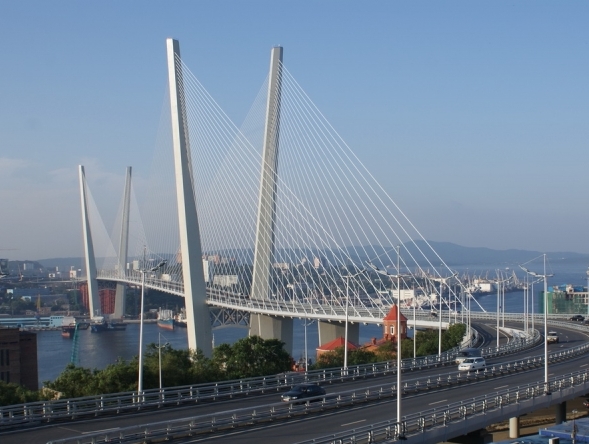
Russia’s Far East Moves Toward Hosting APEC Summit
Publication: Eurasia Daily Monitor Volume: 9 Issue: 155
By:

Russia’s Primorie region in the country’s Far East moved to finalize the construction of high-profile projects, designed to prepare for the upcoming APEC summit meeting next month in Vladivostok. However, Prime Minister Dmitry Medvedev’s recent visit there has only served to underline the continued problems in transportation infrastructure development in the Far East.
On August 11, the authorities inaugurated the Zolotoy Rog Bridge over the Zolotoy Rog Bay in downtown Vladivostok, ahead of the APEC summit (Interfax, RIA Novosti, August 11). Earlier this year, the flagship project, the bridge linking Russky Island and the Russian mainland, was completed to become the longest cable-stayed bridge in the world.
The Primorie region also built a new 3.5-kilometer (2.2 miles) section of the Vladivostok-Nakhodka highway. In all, a total of 120 kilometers (74.5 miles) of new highways have been constructed in preparation for the APEC summit (RG daily, August 7).
Since 2007, the Kremlin has pledged to spend billions of dollars in government funding to build a resort area on Russky Island, off the Pacific port of Vladivostok, to host the APEC summit. The country’s top officials hailed large-scale projects in Vladivostok as a manifestation of the Kremlin’s new emphasis on the Far Eastern development.
However, during his trip to the region on August 6, Prime Minister Medvedev criticized ongoing efforts to improve the transportation infrastructure. Inter-regional transportation, including railways, remain at a low level of development, he said (Interfax, RIA Novosti, August 11).
Medvedev’s criticism was expressed against a backdrop of some unusual public acrimony between two government-controlled corporations with interests in the Far East. Earlier this month, the Russian state-run pipeline giant Transneft accused the railway monopoly RZD of failing to properly handle oil exports via Kozmino port. The accusations followed RZD’s controversial decision in July to limit oil export volumes, which entailed delays in the delivery of crude (Vedomosti, August 7).
RZD lost little time in attempting to defuse the situation. On August 6, RZD head Vladimir Yakunin pledged to sustain the country’s oil exports via Kozmino port and avoid any delays in the future. But he conceded that weeks were needed to tackle the ongoing disorder in crude exports (Interfax, August 8). The Russian railway monopoly has a history of falling behind schedule. In 2011, RZD already paid some 2 billion rubles ($63 million) in fines for delivery delays (Vedomosti, August 7).
APEC top transportation officials, who met in St. Petersburg ahead of the APEC summit, also agreed that Russia needed to do more to develop its regional transportation network. Russia’s Transportation Minister Maxim Sokolov told the meeting that Moscow aimed to funnel as much as ten percent of freight between East Asia and Europe via its railway system (Kommersant, August 6).
Earlier this year, the Kremlin moved to back up its Far Eastern development pledges by initiating institution-building measures. On May 21, Russia’s President Vladimir Putin reformed the government and formed a new entity, the Far Eastern Development Ministry, which is supposed to coordinate the implementation of regional development programs and manage state-owned assets (Interfax, RIA-Novosti, May 21). On August 9, the cabinet allocated 226 million rubles ($7 million) to finance the ministry’s urgent expenses (The Governmental press-service, August 10).
Viktor Ishayev, the presidential envoy to the Far Eastern regions and Khabarovsk regional governor in 1991-2009, was appointed to head the new ministry. In recent years, Ishayev has repeatedly advocated for new measures to encourage economic development in the region. On April 15, he estimated that programs to develop the Far East would require up to 3.3 trillion rubles ($103 billion) over the next decade (RIA Novosti, April 15).
In the past, Ishayev repeatedly warned of the perceived “yellow threat” and speculated that China was considering the annexation of at least 1.5 million hectares (5,792 square miles) of Russian territory. However, in 2003, Putin strongly dismissed Ishayev’s concerns. Subsequently, Ishayev no longer questioned the Kremlin’s policies toward China. Recently, however, fears of the “yellow threat” appear to have resurfaced in Moscow. On August 9, Medvedev urged to protect the country’s Far Eastern regions from what he described as excessive migration inflows of foreign nationals (Interfax, RIA Novosti, August 9).
The showcase projects ahead of the APEC summit in Vladivostok were supposed to demonstrate the Kremlin’s economic ambitions in the Asia-Pacific. Yet, ambitious programs to develop the Far Eastern regions, though supported by the creation of a special-purpose federal ministry, may be hindered by the inadequate development of the inter-regional transportation network. The RZD-Transneft oil-shipment controversy is just one example of how such deficiencies can seriously undermine economic development and trade between the Far East and the rest of Russia. Furthermore, Medvedev’s warning about the need to secure the Far East from large-scale immigration from China suggests that Moscow is still not entirely comfortable with the implications of more closely integrating the region into the Asia-Pacific economy.




